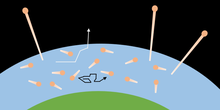User:Atmospheric Anna/sandbox
Wiki page 1: Atmospheric escape
[edit]Atmospheric escape is the loss of planetary atmospheric gases to outer space. A number of different mechanisms can be responsible for atmospheric escape; these processes can be divided into thermal escape, non-thermal (or suprathermal) escape, and impact erosion. The relative importance of each loss process is a function of the planet's escape velocity, its atmosphere composition, and its distance from its sun. Escape occurs when molecular kinetic energy overcomes gravitational energy; in other words, a molecule can escape when it is moving faster than the escape velocity of its planet. Categorizing the rate of atmospheric escape in exoplanets is important to determining whether an atmosphere persists, and so the exoplanet's habitability and likelihood of life.
Thermal escape mechanisms
[edit]Thermal escape occurs if the molecular velocity due to thermal energy is sufficiently high. This covers a range of scales, from molecular evaporation (Jeans escape) to bulk outflow (hydrodynamic escape).

Jeans Escape
[edit]One classical thermal escape mechanism is Jeans escape,[1] , named after British astronomer Sir James Jeans, who first described this process of atmospheric loss.[2] In a quantity of gas, the average velocity of any one molecule is measured by the gas's temperature, but the velocities of individual molecules change as they collide with one another, gaining and losing kinetic energy. The variation in kinetic energy among the molecules is described by the Maxwell distribution. The kinetic energy (), mass (), and velocity () of a molecule are related by . Individual molecules in the high tail of the distribution may reach escape velocity and leave the atmosphere, provided they can escape before undergoing another collision; this happens predominantly in the exosphere, where the mean free path is comparable in length to the pressure scale height. Molecular concentration at the exobase is limited by diffusion through the thermosphere.
Three factors strongly contribute to the relative importance of Jeans escape: mass of the molecule, escape velocity of the planet, and heating of the upper atmosphere by radiation from the parent star. More massive molecules have lower average velocity at a given temperature compared with lighter molecules, and so are less likely to reach escape velocity. This is why hydrogen escapes from an atmosphere more easily than carbon dioxide. Second, a planet with a larger mass has more gravity, so the escape velocity is greater, and fewer particles will gain the energy required to escape. This is why the gas giant planets still retain significant amounts of hydrogen, which escape more readily from Earth's atmosphere. Finally, the distance a planet orbits from a star also plays a part; a close planet has a hotter atmosphere, with higher velocities and hence, a greater likelihood of escape. A distant body has a cooler atmosphere, with lower velocities, and less chance of escape.

Hydrodynamic escape
[edit]An atmosphere with a high enough pressure and temperature can also undergo hydrodynamic escape. In this case, a large amount of thermal energy, usually through extreme ultraviolet radiation, is deposited into the atmosphere. As molecules are heated, they expand upwards and are further accelerated until they reach escape velocity. In this process, lighter molecules can drag heavier molecules with them through collisions as a larger quantity of gas escapes.[3] Hydrodynamic escape has been observed for exoplanets close to their host star, including the hot Jupiter HD 209458b.[4]
Non-thermal (suprathermal) escape
[edit]Non-thermal or suprathermal escape describes escape due to non-thermal interactions. Most of these processes occur due to photochemistry or charged particle (ion) interactions.
Photochemical escape
[edit]In the upper atmosphere, high energy ultraviolet photons can react more readily with molecules. Photodissociation can provide enough energy for products to escape. Photoionization produces ions, which can get trapped in the planet's magnetosphere or undergo dissociative recombination. In the first case, these ions may undergo escape mechanisms described below. In the second case, the ion recombines with an electron, releases energy, and can escape.[5]
Sputtering escape
[edit]Excess kinetic energy from the solar wind can impart sufficient energy to eject atmospheric particles, similar to sputtering from a solid surface. This type of interaction is more pronounced in the absence of a planetary magnetosphere, as the electrically charged solar wind is deflected by magnetic fields, which mitigates the loss of atmosphere.[6]

Charge exchange escape
[edit]Ions in the solar wind or magnetosphere can charge exchange with molecules in the upper atmosphere. A fast-moving ion can capture the electron from a slow atmospheric neutral, creating a fast neutral and a slow ion. The slow ion is trapped on the magnetic field lines, but the fast neutral can escape.[5]
Polar wind escape
[edit]Atmospheric molecules can also escape from the polar regions on a planet with a magnetosphere, due to the polar wind. Near the poles of a magnetosphere, the magnetic field lines are open, allowing a pathway for ions in the atmosphere to exhaust into space.[8]

Impact erosion
[edit]The impact of a large meteoroid can lead to the loss of atmosphere. If a collision is energetic enough, it is possible for ejecta, including atmospheric molecules, to reach escape velocity. "... the amount of ejecta which can escape from a planet ... depends only on impact velocity ... whereas the net gain or loss of a planetary atmosphere depends on total impact energy." [9]
In order to have a significant effect on atmospheric escape, the radius of the impacting body must be larger than the scale height. The projectile can impart momentum, and thereby facilitate escape of the atmosphere, in three main ways: (a) the meteroid heats and accelerates the gas it encounters as it travels through the atmosphere, (b) solid ejecta from the impact crater heat atmospheric particles through drag as they are ejected, and (c) the impact creates vapor which expands away from the surface. In the first case, the heated gas can escape in a manner similar to hydrodynamic escape, albeit on a more localized scale. Most of the escape from impact erosion occurs due to case (c).[9] The maximum atmosphere that can be ejected is above a plane tangent to the impact site.
Dominant atmospheric escape and loss processes in the Solar System
[edit]Earth
[edit]Atmospheric escape of hydrogen on Earth is due to Jeans escape (~10 - 40%), charge exchange escape (~ 60 - 90%), and polar wind escape (~ 10 - 15%), currently losing about 3 kg/s of hydrogen.[10] The Earth additionally loses approximately 50 g/s of helium primarily through polar wind escape. Escape of other atmospheric constituents is much smaller.[10] A Japanese research team in 2017 found some oxygen ions on the moon that came from the Earth.[11]
In 1 billion years, the Sun will be 10% brighter than it is now, making it hot enough for Earth to lose enough hydrogen to space to cause it to lose all of its water (See Future of Earth#Loss of oceans).
Venus
[edit]Recent models indicate that hydrogen escape on Venus is almost entirely due to suprathermal mechanisms, primarily photochemical reactions and charge exchange with the solar wind. Oxygen escape is dominated by charge exchange and sputtering escape.[12] Venus Express measured the effect of coronal mass ejections on the rate of atmospheric escape of Venus, and researchers found a factor of 1.9 increase in escape rate during periods of increased coronal mass ejections compared with calmer space weather.[13]
Mars
[edit]Primordial Mars also suffered from the cumulative effects of multiple small impact erosion events,[14] and recent observations with MAVEN suggest that 66% of the Martian atmosphere has been lost over time, due to suprathermal escape.[15] The loss of a magnetosphere likely increased the rate of atmospheric escape in primordial Mars.[16]
The MAVEN mission has also explored the current rate of atmospheric escape of Mars. Jeans escape plays an important role in the continued escape of hydrogen on Mars, contributing to a loss rate that varies between 160 - 1800 g/s. [17] Oxygen loss is dominated by suprathermal methods: photochemical (~ 1300 g/s), charge exchange (~ 130 g/s), and sputtering (~ 80 g/s) escape combine for a total loss rate of ~ 1500 g/s. Other heavy atoms, such as carbon and nitrogen, are primarily lost due to photochemical reactions and interactions with the solar wind.[18][19]
Titan and Io
[edit]Saturn's moon Titan and Jupiter's moon Io have atmospheres and are subject to atmospheric loss processes. They have no magnetic fields of their own, but orbit planets with powerful magnetic fields, which protects these moons from the solar wind when its orbit is within the bow shock. However Titan spends roughly half of its transit time outside of the bow-shock, subjected to unimpeded solar winds. The kinetic energy gained from pick-up and sputtering associated with the solar winds increases thermal escape throughout the transit of Titan, causing neutral hydrogen to escape.[20] The escaped hydrogen maintains an orbit following in the wake of Titan, creating a neutral hydrogen torus around Saturn. Io, in its transit around Jupiter, encounters a plasma cloud.[21] Interaction with the plasma cloud induces sputtering, kicking off sodium particles. The interaction produces a stationary banana-shaped charged sodium cloud along a part of the orbit of Io.
Observations of exoplanet atmospheric escape
[edit]Studies of exoplanets have measured atmospheric escape as a means of determining atmospheric composition and habitability. The most common method is Lyman-alpha line absorption. Much as exoplanets are discovered using the dimming of a distant star's brightness (transit), looking specifically at wavelengths corresponding to hydrogen absorption describes the amount of hydrogen present in a sphere around the exoplanet.[22] This method indicates that the hot Jupiters HD209458b[23] and HD189733b[24] and Hot Neptune GJ436b[25] are experiencing significant atmospheric escape.
Other atmospheric loss mechanisms
[edit]Sequestration is not a form of escape from the planet, but a loss of molecules from the atmosphere and into the planet. It occurs on Earth when water vapor condenses to form rain or glacial ice, when carbon dioxide is sequestered in sediments or cycled through the oceans, or when rocks are oxidized (for example, by increasing the oxidation states of ferric rocks from Fe2+ to Fe3+). Gases can also be sequestered by adsorption, where fine particles in the regolith capture gas which adheres to the surface particles.
Wiki page 2: Hydrodynamic Escape
[edit]Hydrodynamic escape refers to a thermal atmospheric escape mechanism that can lead to the escape of heavier atoms of a planetary atmosphere through numerous collisions with lighter atoms.

Description
[edit]Hydrodynamic escape occurs if there is a strong thermally driven atmospheric escape of light atoms which, through drag effects (collisions), also drive off heavier atoms.[26] The heaviest species of atom that can be removed in this manner is called the cross-over mass. [27]
In order to maintain a significant hydrodynamic escape, a large source of energy at a certain altitude is required. Soft X-ray or extreme ultraviolet radiation, momentum transfer from impacting meteoroids or asteroids, or the heat input from planetary accretion processes[28] may provide the requisite energy for hydrodynamic escape.
Calculations
[edit]Estimating the rate of hydrodynamic escape is important in analyzing both the history and current state of a planet's atmosphere. In 1981, Watson et al published[29] calculations that describe energy-limited escape, where all incoming energy is balanced by escape to space. Recent numerical simulations on exoplanets have suggested that this calculation overestimates the hydrodynamic flux by 20 - 100 times.[30] However, as an special case and upper limit approximation on the atmospheric escape, it is worth noting here.
Hydrodynamic escape flux (, [ms]) in an energy-limited escape can calculated, assuming (1) an atmosphere comprised of non-viscous, (2) constant molecular weight gas, with (3) isotropic pressure, (4) fixed temperature, (5) perfect XUV absorption, and that (6) pressure decreases to zero as distance from the planet increases.[29]
where is the photon flux [J ms] over the wavelengths of interest, is the radius of the planet, is the gravitational constant, is the mass of the planet, and is the effective radius where the XUV absorption occurs. Corrections to this model have been proposed over the years to account for the Roche lobe of a planet and efficiency in absorbing photon flux. [30][31][32]
However, as computational power has improved, increasingly sophisticated models have emerged, incorporating radiative transfer, photochemistry, and hydrodynamics that provide better estimates of hydrodynamic escape.[33]
Isotope fractionation as evidence
[edit]The root mean square thermal velocity () of an atomic species is
where is the Boltzmann constant, is the temperature, and is the mass of the species. Lighter molecules or atoms will therefore be moving faster than heavier molecules or atoms at the same temperature. This is why atomic hydrogen escapes preferentially from an atmosphere and also explains why the ratio of lighter to heavier isotopes of atmospheric particles can indicate hydrodynamic escape.
Specifically, the ratio of different noble gas isotopes (20Ne/22Ne, 36Ar/38Ar, 78,80,82,83,86Kr/84Kr, 124,126,128,129,131,132,134,136Xe/130Xe) or hydrogen isotopes (D/H) can be compared to solar levels to indicate likelihood of hydrodynamic escape in the atmospheric evolution. Ratios different compared with that in the sun or CI chondrites, as a solar proxy, indicate that significant hydrodynamic escape has occurred since the formation of the planet. Since lighter atoms preferentially escape, we expect smaller ratios for the noble gas isotopes (or a larger D/H) correspond to a greater likelihood of hydrodynamic escape.
| Source | 36Ar/38Ar | 20Ne/22Ne | 82Kr/84Kr | 128Xe/130Xe |
|---|---|---|---|---|
| Sun | 5.8 | 13.7 | 20.501 | 50.873 |
| CI chondrites | 5.3±0.05 | 8.9±1.3 | 20.149±0.080 | 50.73±0.38 |
| Venus | 5.56±0.62 | 11.8±0.7 | -- | -- |
| Earth | 5.320±0.002 | 9.800±0.08 | 20.217±0.021 | 47.146±0.047 |
| Mars | 4.1±0.2 | 10.1±0.7 | 20.54±0.20 | 47.67±1.03 |
Matching these ratios can also be used to validate or verify computational models seeking to describe atmospheric evolution. This method has also been used to determine the escape of oxygen relative to hydrogen in early atmospheres. [35]
Examples
[edit]Exoplanets that are extremely close to their parent star, such as hot Jupiters can experience significant hydrodynamic escape[36][37] to the point where the star "burns off" their atmosphere. At this point, they cease to be gas giants, are left with just the core, and are called Chthonian planets. Hydrodynamic escape has been observed for exoplanets close to their host star, including the hot Jupiters HD 209458b. [38]
Within a stellar lifetime, the solar flux may change. Scientists see this in our own solar system, where a younger sun produced more EUV. Early protoatmospheres of Earth, Mars, and Venus likely underwent hydrodynamic escape, which accounts for the noble gas isotope fractionation present in their atmospheres, as shown in the table above. [39]
- ^ David C. Catling and Kevin J. Zahnle, The Planetary Air Leak, Scientific American, May 2009, p. 26 (accessed 25 July 2012)
- ^ Muriel Gargaud, Encyclopedia of Astrobiology, Volume 3, Springer Science & Business Media, May 26, 2011, p. 879.
- ^ Catling, David C.; Zahnle, Kevin J. (2009). "The Planetary Air Leak". Scientific American. 300 (5): 36–43. doi:10.1038/scientificamerican0509-36. ISSN 0036-8733. JSTOR 26001341.
- ^ "Vidal-Madjar et al., Oxygen and Carbon in HD 209458b". iopscience.iop.org. arXiv:astro-ph/0401457. doi:10.1086/383347. S2CID 18972146. Retrieved 2019-06-06.
- ^ a b Shematovich, V I; Marov, M Ya (2018-03-31). "Escape of planetary atmospheres: physical processes and numerical models". Physics-Uspekhi. 61 (3): 217–246. doi:10.3367/ufne.2017.09.038212. ISSN 1063-7869. S2CID 125191082.
- ^ Lundin, Rickard; Lammer, Helmut; Ribas, Ignasi (2007-08-17). "Planetary Magnetic Fields and Solar Forcing: Implications for Atmospheric Evolution". Space Science Reviews. 129 (1–3): 245–278. doi:10.1007/s11214-007-9176-4. ISSN 0038-6308. S2CID 122016496.
- ^ Goldston, R. J. (1995). Introduction to plasma physics. Rutherford, P. H. (Paul Harding), 1938-. Bristol, UK: Institute of Physics Pub. ISBN 0750303255. OCLC 33079555.
- ^ "The curious case of Earth's leaking atmosphere". phys.org. Retrieved 2019-05-28.
- ^ a b Ahrens, T J (1993). "Impact Erosion of Terrestrial Planetary Atmospheres". Annual Review of Earth and Planetary Sciences. 21 (1): 525–555. doi:10.1146/annurev.ea.21.050193.002521. hdl:2060/19920021677. ISSN 0084-6597.
- ^ a b David C. Catling and Kevin J. Zahnle, The Planetary Air Leak, Scientific American, May 2009, p. 26 (accessed 25 July 2012)
- ^ http://www.space.com/35502-moon-has-oxygen-from-earth-plants.html
- ^ Lammer, H.; Lichtenegger, H. I. M.; Biernat, H. K.; Erkaev, N. V.; Arshukova, I. L.; Kolb, C.; Gunell, H.; Lukyanov, A.; Holmstrom, M.; Barabash, S.; Zhang, T. L.; Baumjohann, W. (2006). "Loss of hydrogen and oxygen from the upper atmosphere of Venus". Planetary and Space Science. 54 (13–14): 1445–1456. Bibcode:2006P&SS...54.1445L. CiteSeerX 10.1.1.484.5117. doi:10.1016/j.pss.2006.04.022. S2CID 123628031.
- ^ Edberg, N. J. T.; Nilsson, H.; Futaana, Y.; Stenberg, G.; Lester, M.; Cowley, S. W. H.; Luhmann, J. G.; McEnulty, T. R.; Opgenoorth, H. J. (2011). "Atmospheric erosion of Venus during stormy space weather". Journal of Geophysical Research: Space Physics. 116 (A9). doi:10.1029/2011JA016749. ISSN 2156-2202.
- ^ Melosh, H.J.; Vickery, A.M. (April 1989). "Impact erosion of the primordial atmosphere of Mars". Nature. 338 (6215): 487–489. Bibcode:1989Natur.338..487M. doi:10.1038/338487a0. PMID 11536608. S2CID 4285528.
- ^ Alsaeed, N.; Stone, S.; Yelle, R.; Elrod, M.; Mahaffy, P.; Benna, M.; Slipski, M.; Jakosky, B. M. (2017-03-31). "Mars' atmospheric history derived from upper-atmosphere measurements of 38Ar/36Ar". Science. 355 (6332): 1408–1410. doi:10.1126/science.aai7721. ISSN 0036-8075. PMID 28360326. S2CID 206652948.
- ^ Chassefière, Eric; Leblanc, François; Langlais, Benoit (2007-02-01). "The combined effects of escape and magnetic field histories at Mars". Planetary and Space Science. Planet Mars II. 55 (3): 343–357. doi:10.1016/j.pss.2006.02.003. ISSN 0032-0633.
- ^ Jakosky, B. M.; Brain, D.; Chaffin, M.; Curry, S.; Deighan, J.; Grebowsky, J.; Halekas, J.; Leblanc, F.; Lillis, R. (2018-11-15). "Loss of the Martian atmosphere to space: Present-day loss rates determined from MAVEN observations and integrated loss through time". Icarus. 315: 146–157. doi:10.1016/j.icarus.2018.05.030. ISSN 0019-1035. S2CID 125410604.
- ^ David C. Catling and Kevin J. Zahnle, The Planetary Air Leak, Scientific American, May 2009, p. 26 (accessed 25 July 2012)
- ^ Lammer, H.; Lichtenegger, H. I. M.; Biernat, H. K.; Erkaev, N. V.; Arshukova, I. L.; Kolb, C.; Gunell, H.; Lukyanov, A.; Holmstrom, M.; Barabash, S.; Zhang, T. L.; Baumjohann, W. (2006). "Loss of hydrogen and oxygen from the upper atmosphere of Venus". Planetary and Space Science. 54 (13–14): 1445–1456. Bibcode:2006P&SS...54.1445L. CiteSeerX 10.1.1.484.5117. doi:10.1016/j.pss.2006.04.022. S2CID 123628031.
- ^ Lammer, H.; Stumptner, W.; Bauer, S. J. (1998). "Dynamic escape of H from Titan as consequence of sputtering induced heating". Planetary and Space Science. 46 (9–10): 1207–1213. Bibcode:1998P&SS...46.1207L. doi:10.1016/S0032-0633(98)00050-6.
- ^ Wilson, J. K.; Mendillo, M.; Baumgardner, J.; Schneider, N. M.; Trauger, J. T.; Flynn, B. (2002). "The dual sources of Io's sodium clouds". Icarus. 157 (2): 476–489. Bibcode:2002Icar..157..476W. doi:10.1006/icar.2002.6821.
- ^ Owen, James E. (2019-05-30). "Atmospheric Escape and the Evolution of Close-In Exoplanets". Annual Review of Earth and Planetary Sciences. 47 (1): 67–90. arXiv:1807.07609. doi:10.1146/annurev-earth-053018-060246. ISSN 0084-6597. S2CID 119333247.
- ^ Vidal-Madjar, A.; des Etangs, A. Lecavelier; Désert, J.-M.; Ballester, G. E.; Ferlet, R.; Hébrard, G.; Mayor, M. (2003-3). "An extended upper atmosphere around the extrasolar planet HD209458b". Nature. 422 (6928): 143–146. doi:10.1038/nature01448. ISSN 0028-0836. PMID 12634780. S2CID 4431311.
{{cite journal}}: Check date values in:|date=(help) - ^ Lecavelier des Etangs, A.; Ehrenreich, D.; Vidal-Madjar, A.; Ballester, G. E.; Désert, J.-M.; Ferlet, R.; Hébrard, G.; Sing, D. K.; Tchakoumegni, K.-O. (2010-5). "Evaporation of the planet HD 189733b observed in H I Lyman- α". Astronomy and Astrophysics. 514: A72. doi:10.1051/0004-6361/200913347. ISSN 0004-6361. S2CID 53408874.
{{cite journal}}: Check date values in:|date=(help) - ^ Ehrenreich, David; Bourrier, Vincent; Wheatley, Peter J.; des Etangs, Alain Lecavelier; Hébrard, Guillaume; Udry, Stéphane; Bonfils, Xavier; Delfosse, Xavier; Désert, Jean-Michel (2015-6). "A giant comet-like cloud of hydrogen escaping the warm Neptune-mass exoplanet GJ 436b". Nature. 522 (7557): 459–461. arXiv:1506.07541. doi:10.1038/nature14501. ISSN 0028-0836. PMID 26108854. S2CID 4388969.
{{cite journal}}: Check date values in:|date=(help) - ^ Irwin, Patrick G. J. (2006). Giant planets of our solar system: an introduction. Birkhäuser. p. 58. ISBN 3-540-31317-6. Retrieved 22 Dec 2009.
- ^ Hunten, Donald M.; Pepin, Robert O.; Walker, James C. G. (1987-03-01). "Mass fractionation in hydrodynamic escape". Icarus. 69 (3): 532–549. doi:10.1016/0019-1035(87)90022-4. hdl:2027.42/26796. ISSN 0019-1035.
- ^ Pater, Imke De; Jack Jonathan Lissauer (2001). Planetary sciences. Cambridge University Press. p. 129. ISBN 0-521-48219-4.
- ^ a b Watson, Andrew J.; Donahue, Thomas M.; Walker, James C.G. (November 1981). "The dynamics of a rapidly escaping atmosphere: Applications to the evolution of Earth and Venus". Icarus. 48 (2): 150–166. doi:10.1016/0019-1035(81)90101-9. hdl:2027.42/24204.
- ^ Erkaev, N. V.; Kulikov, Yu. N.; Lammer, H.; Selsis, F.; Langmayr, D.; Jaritz, G. F.; Biernat, H. K. (2007-9). "Roche lobe effects on the atmospheric loss from "Hot Jupiters"". Astronomy & Astrophysics. 472 (1): 329–334. doi:10.1051/0004-6361:20066929. ISSN 0004-6361. S2CID 16467963.
{{cite journal}}: Check date values in:|date=(help) - ^ Lecavelier des Etangs, A. (2007-1). "A diagram to determine the evaporation status of extrasolar planets". Astronomy & Astrophysics. 461 (3): 1185–1193. doi:10.1051/0004-6361:20065014. ISSN 0004-6361. S2CID 8532526.
{{cite journal}}: Check date values in:|date=(help) - ^ Tian, Feng; Güdel, Manuel; Johnstone, Colin P.; Lammer, Helmut; Luger, Rodrigo; Odert, Petra (2018-4). "Water Loss from Young Planets". Space Science Reviews. 214 (3). doi:10.1007/s11214-018-0490-9. ISSN 0038-6308. S2CID 126177273.
{{cite journal}}: Check date values in:|date=(help) - ^ Owen, James E. (2019-05-30). "Atmospheric Escape and the Evolution of Close-In Exoplanets". Annual Review of Earth and Planetary Sciences. 47 (1): 67–90. arXiv:1807.07609. doi:10.1146/annurev-earth-053018-060246. ISSN 0084-6597. S2CID 119333247.
- ^ Pepin, Robert O. (1991-07-01). "On the origin and early evolution of terrestrial planet atmospheres and meteoritic volatiles". Icarus. 92 (1): 2–79. doi:10.1016/0019-1035(91)90036-S. ISSN 0019-1035.
- ^ Hunten, Donald M.; Pepin, Robert O.; Walker, James C. G. (1987-03-01). "Mass fractionation in hydrodynamic escape". Icarus. 69 (3): 532–549. doi:10.1016/0019-1035(87)90022-4. hdl:2027.42/26796. ISSN 0019-1035.
- ^ Tian, Feng; Toon, Owen B.; Pavlov, Alexander A.; de Sterck, H. (March 10, 2005). "Transonic Hydrodynamic Escape of Hydrogen from Extrasolar Planetary Atmospheres". The Astrophysical Journal. 621 (2): 1049–1060. Bibcode:2005ApJ...621.1049T. CiteSeerX 10.1.1.122.9085. doi:10.1086/427204. S2CID 6475341.
- ^ Swift, Damian C.; Eggert, Jon; Hicks, Damien G.; Hamel, Sebastien; Caspersen, Kyle; Schwegler, Eric; Collins, Gilbert W. (2012). "Mass-radius relationships for exoplanets". The Astrophysical Journal. 744 (1): 59. arXiv:1001.4851. Bibcode:2012ApJ...744...59S. doi:10.1088/0004-637X/744/1/59. S2CID 119219137.
- ^ "Vidal-Madjar et al., Oxygen and Carbon in HD 209458b". iopscience.iop.org. arXiv:astro-ph/0401457. doi:10.1086/383347. S2CID 18972146. Retrieved 2019-06-06.
- ^ Gillmann, Cédric; Chassefière, Eric; Lognonné, Philippe (2009-09-15). "A consistent picture of early hydrodynamic escape of Venus atmosphere explaining present Ne and Ar isotopic ratios and low oxygen atmospheric content". Earth and Planetary Science Letters. 286 (3): 503–513. doi:10.1016/j.epsl.2009.07.016. ISSN 0012-821X.

















